Museum Models 1/72 scale
Macchi M.39
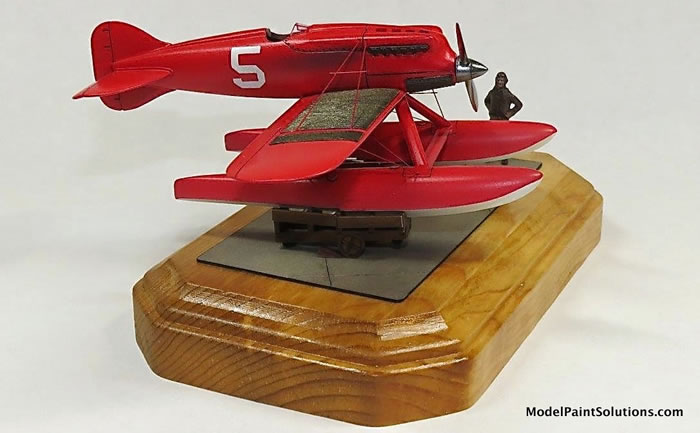
by Tim Nelson

The racing seaplanes which emerged from the later years of the Schneider Trophy contest have an enduring allure. The 1926 Macchi M.39 in particular is unquestionably on the short list of most beautiful flying machines of all time. Unfortunately, model kits of this genre are generally limited to short run efforts, which vary greatly in quality and difficulty. Karaya, CMR, SBS Model, and some others have produced decent kits of these subjects, but they definitely require extra modeling skills. We are fortunately seeing a bit of a Golden Age of vintage racer models, with modern styrene kits coming from modern mainstream manufacturers like AMP – a hopeful sign.
History
Jacques Schneider was a wealthy heir to his family’s armaments business. A financier, boat racer, and balloonist, he was also a friend and student of pioneer French aviator Louis Bleriot. Inspired by publisher Gordon Bennett’s sponsorship of one of the earliest air racing prizes, he decided to inaugurate his own racing series. Thinking logically in these infant days of human flight, with the Earth being two thirds ocean-covered, clearly the future would belong to far-ranging seaplanes. With that in mind, in late 1912 he announced the Coupe d'Aviation Maritime Jacques Schneider, better known as the Schneider Trophy (it was not a cup). It was to be a racing series for seaplanes, with each event including seaworthiness trials and culminating in a speed contest over a closed circuit. The winning entry would be based on minimum time over the required number of laps (not head-to-head racing), never less than 150 nautical miles. Mssr. Schneider wanted to encourage development efforts, so the competition was designed to be long term - the first nation to win 3 of 5 contests would secure the Schneider Trophy in perpetuity.
The initial events in 1913 and 1914 were held in Monaco and won by French and British entries, respectively. The Great War intervened but the series resumed at Bournemouth, England in 1919 – that event was unfortunately declared null due to fog, confusion, and chaos on the racing course. Italian entries prevailed in 1920 and 1921 but the British saved the series with a win in 1922. The Americans stole the show with advanced Curtiss biplane racers in 1923 and 1925, thus setting the stage to retire the trophy at the 1926 event staged at Hampton Roads, VA.
Recent developments would greatly influence the remainder of the Schneider series. The Curtiss CR-3 and R3C-2 racers flown to respective victories in the previous contests by Lt. David Rittenhouse and Maj. Jimmy Doolittle, incorporated flush surface radiators on the wings. This design significantly reduced drag and allowed for higher engine power. The Supermarine S.4, which entered in 1925 but was lost in a qualifying accident, was nonetheless a watershed design. Its monoplane-on-floats configuration became the template for the culminating years of the Schneider competition. (Its bold wing design with no external bracing was innovative, but subsequent Schneider designs would return to tried-and-true external bracing.) The Italians entered a flying boat in 1925 which was not competitive – but Macchi’s chief designer Mario Castoldi was on-site and absorbing all he could from the Curtiss and Supermarine designs.
The result of this fermentation was a new Italian design for 1926, designated the Macchi M.39. Constructed mostly of wood, with state-of-the-art brass surface radiators, and powered by an 800 horsepower Fiat AS.2 engine, the all-red machine was a stunner. Two airframes with wooden propellers were built for training, and three with steel Reed props for the 1926 Schneider race itself. The M.39 first flew on 30 August, 1926. One fatal accident marred the test program, but the three competition aircraft were soon readied and shipped to the USA.
Benito Mussolini’s regime in Italy was in its early years, and he appreciated the propaganda value of high profile international success – and nothing in air racing was as high profile as the Schneider Trophy became in its later years. He directed the Macchi team to win at all costs. Three pilots were assigned to the racing team: Adriano Bacula (race #1), Arturo Ferrarin (race #3), and Mario De Bernardi (race #5). All three worked their way through the navigability trials, although Ferrarin’s machine required a major engine repair.
The final speed contest was held on 13 November, 1926. The Americans, despite being on the cusp of ultimate Schneider victory, only fielded warmed-over Curtiss racers from 1925. The British, despite the innovative Supermarine S.4 the year before, did not have any entries ready at all. Ferrarin retired and the race was won in style by Mario De Bernardi – he sent a post-race telegram to Mussolini stating: “Your order to win at all costs has been carried out.” For emphasis, De Bernardi took the airplane out on 17 November to set a new seaplane speed record of 258.874 mph over a 3 km course. The next year, he would set a new absolute speed record in the follow-on Macchi M.52, ushering in a period of several years where seaplanes were the world’s fastest airplanes.
The Macchi M.39 win in 1926 was the high-water mark for the Italians in the series. A resurgent Supermarine, led by the brilliance of chief designer R.J. Mitchell, would win the next 3 events in 1927, 1929, and 1931 to permanent retire the Schneider Trophy. The ultimate Italian racer, the Macchi-Castoldi M.C.72, was not ready in time for the final Schneider contest but would set an absolute speed record of 440 mph in 1934 – a record which stood outright for 5 years, and for propeller-driven seaplanes still stands in 2020.
De Bernardi’s 1926 race-winning Macchi M.39 aircraft actually still exists, nearing its 100th birthday, on display with revised markings at the Museo Storico dell'Aeronautica Militare, Vigna di Valle, Italy (a little north of Rome on Lake Bracciano). I need to visit that place someday.
The Kit
I don’t recall when or how I acquired this kit, but I suspect it was about 15 years ago when I was able to frequent the Aviation Megastore (Luchtvaart Hobby Shop) on recurring business trips to Amsterdam. The resin kit is dimensionally accurate, but suffers from some casting bubbles in the wing leading edge. The cruciform vertical and horizontal tails are a bit thick where they mate with the fuselage, so some sanding is needed for flush fit there. The most unique aspect of the kit are sheets of corrugated photo-etched metal, which looks like copper but might be brass, to emulate the brass flush radiator surfaces. It retained some stains from the PE process, and didn’t capture the in-scale look in my mind’s eye, so I would later paint it. Many of these segments also require gentle shaping to conform to the wing camber, which I did by annealing over a flame and bending as gently as I could. Since the needed bending is perpendicular to the corrugation runs, it’s hard to avoid kinking. The corrugations are also missing some perpendicular runs visible in photos, but I lived with that.
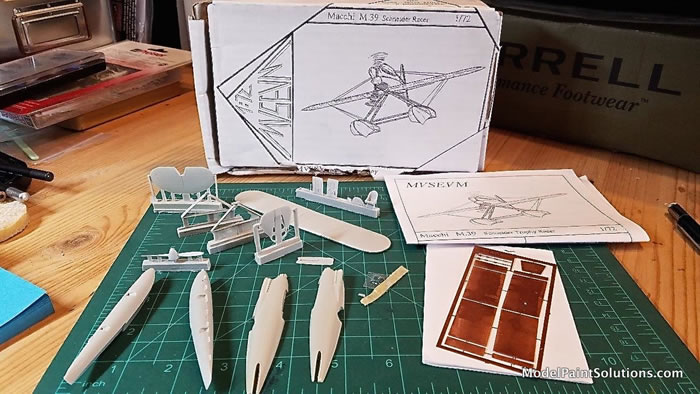

A nice prototypical detail captured by the model is that the wing semi-span is asymmetric - port side is about 6” longer than starboard at full scale.
There are many drawings of the M.39 with a variety of markings, all lurid red, but photos of the three machines at the 1926 race on Chesapeake Bay show nothing other than a large white race number on the fuselage. There are no kit decals, but we’ll deal with that down the road. I wanted to model De Bernardi’s 1926 race winner, which would simply entail creating a large numeral “5” on each side of the fuselage.
Near as I can tell, this is the world’s only M.39 kit in the divine scale of 1/72. (There are a couple of kits in larger scales.) A kit of the follow-on 1927 Macchi M.52 under the “Vintage” label, appears to be based on many of the same masters as this kit, with revised wings and PE radiator sheet.
All in all, I’ve seen worse – much worse.
After the usual cleaning in a warm soapy bath of Dawn, and a few hours of surface prep and hole-filling, I commenced with more fun aspects of the build. My list of modifications includes the following:
-
Added scratch cockpit details such as throttle, belts, & headrest; spruced up kit instrument panel
-
Scratchbuilt windscreen (The kit comes with a smash-formed canopy but it had too many imperfections to use)
-
Scratchbuilt beaching gear based on photos
-
Scribed and added detail to floats
-
Replaced too-short front struts with scratch brass pair, using brass tubing with brass rod insert; lots of cleanup around strut/float join area
-
Added bracing struts to top & bottom wing
-
Added pitot probe to starboard wing per photos
-
Scratch "concrete" base with repurposed Hasegawa USN WWII pilot figure (who unfortunately doesn’t look much like Mario de Bernardi)
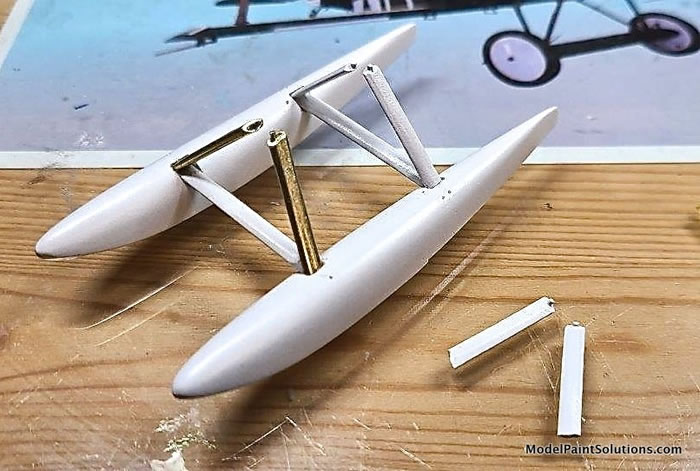
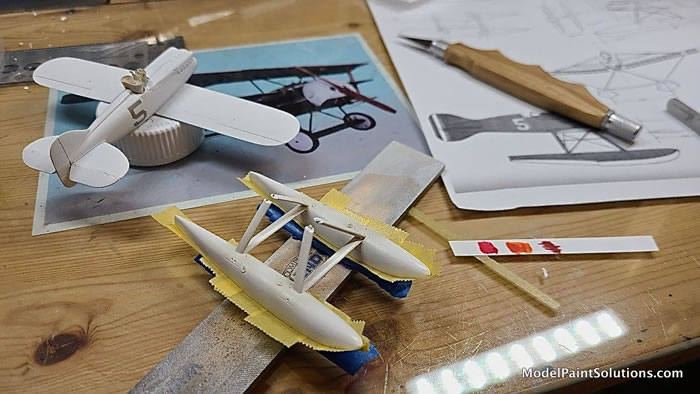

Fit of the zero-dihedral wing onto the lower fuselage is a little tricky, mostly because of a fairing transitioning to the aft fuselage – you need to create that bump yourself. I used a couple of iterations of Perfect Plastic Putty. It’s also important to carefully think through how the float struts will mount to the airframe – pins are required and I devoted a lot of test fitting to try to make it as easy as possible later on. It was still a struggle.
The aforementioned PE sheet also provides bits which represent louver grills on the upper cowling above the engine. I wish I’d really thought through a better way to emulate this feature early on – the PE doesn’t really look right and also stands a bit proud of the surface. To make things worse, I lost one of these 8 bits and had to reproduce something similar using fine copper wire ganged together with CA glue.
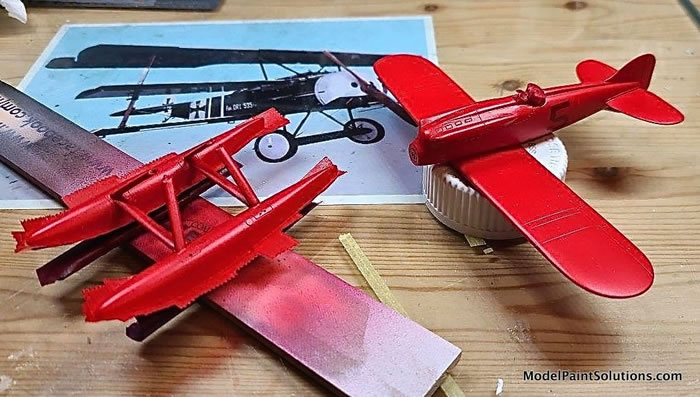
After a good precautionary swab-down with denatured alcohol, it was time for paint:
-
Rattle can Krylon ColorMaxx Paint+Primer Semi-Gloss White (This stuff is really useful when you want a quick, effective primer. It goes on fast but levels well, fills tiny scratches, and cures quickly to a rock-hard finish. And no clean up!)
-
Masked the fuselage “5” numbers using stencils I created eye-balling photos with Silhouette Cameo 3 cutter.
-
(All painting from here on out was applied using a Harder & Steenbeck Infinity with a 0.2 mm tip.) Initial red treatment was a 50/50 mix of Mission Models MMP-003 Red and MMP-101 Insignia Red. I thought the resulting look was too eye-poppingly bright for the scale, so I came back with some layers of just MMP-003 Red until my Mark I eyeball thought it looked representative. Matching fine color hue is a fool’s errand, so I’m aiming for “looks about right.”
-
Bracing wires, described below, were treated to same white primer and red paint as the fuselage.
-
I then masked and painted exhaust stacks with a 50/50 mix of Mission Black and White.
-
My intent was to depict light, subject-appropriate weathering. After a panel line treatment with the Tamiya black panel line wash, I airbrushed exhaust streaks with a thin dark gray, and applied a little float wear and discoloration with Mission Models MMP-069 Light Gull Gray.
-
Final coat of Mission Thinner mixed 70:30 with Mission clear primer (dubbed “CP30” by John Miller), which makes for a very nice scale-looking satin sheen.
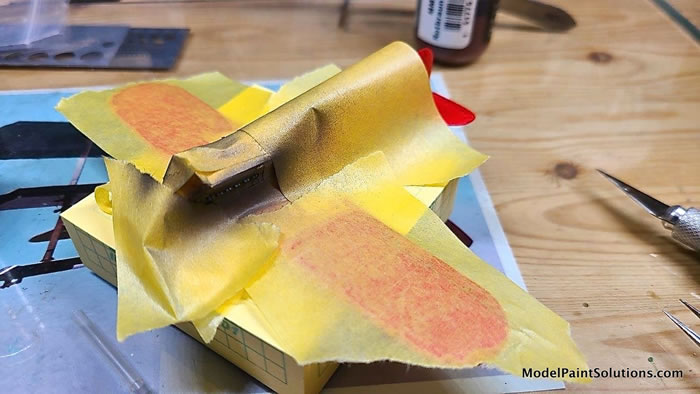
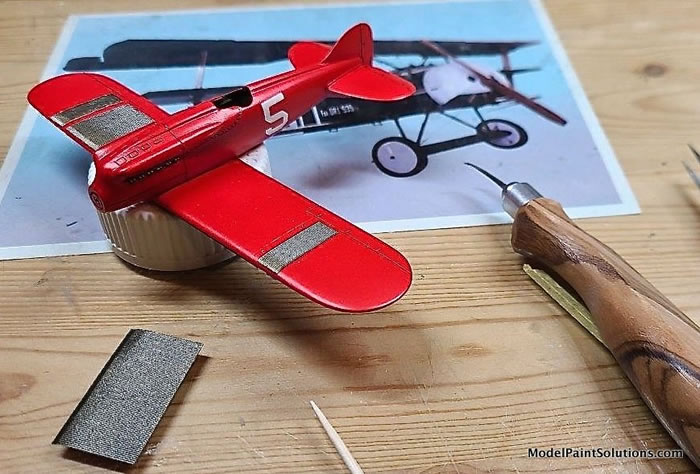
The PE radiators were painted with the miraculous rattle can Krylon ColorMaxx Paint+Primer Gloss Black, then after curing, Mission MMC-002 Brass. (The Krylon can says 1 hour, but I waited a day – still impressive and easy.) After the brass treatment cured a day, I applied a wash I learned about via Ray Rimell (in his book Building the Wingnut Wings Sopwith Camel, Albatros Productions): 40% Pledge Floor Gloss (Future), 40% water, and 20% your desired acrylic tints (Mission Black and Brown in my case). This type of wash works beautifully in situations where you have fine lines for capillary action, and will not be doing any post-application swabbing. It was perfect for these radiator grooves (and also subjects like engine cylinder cooling fins, not applicable in this build).
The one-piece propeller assembly was also treated with Krylon gloss black, then Alclad Polished aluminum. I then masked the blades and hit the spinner with Mission Aluminum and Duraluminum. I needed to scribe a circumferential separation line per photos, so I chucked the piece in a low RPM electric screwdriver and let it pass gently over a fixed #11 blade to achieve this effect.
After this prep, the radiators were carefully laid down with thin CA glue and the Looper 2.0 tool. This and later Macchi racers used external bracing, which was streamlined. This model is 1/72 scale, but the airfoil cross-section of the bracing is quite distinct, so I searched for a suitable material. My gaze fell upon the RB Productions streamlined RAF wire in photo-etched steel that I had on hand from a previous 1/32 scale Sopwith Camel; in particular, the 2BA size used for secondary bracing on the Camel. I think it looks about right on the Macchi.
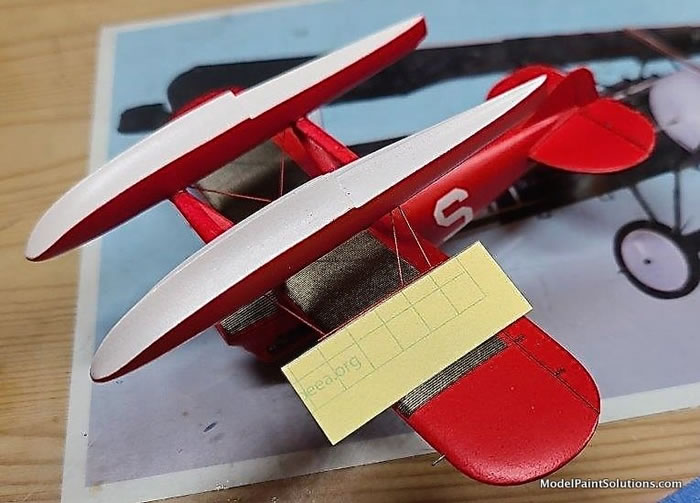
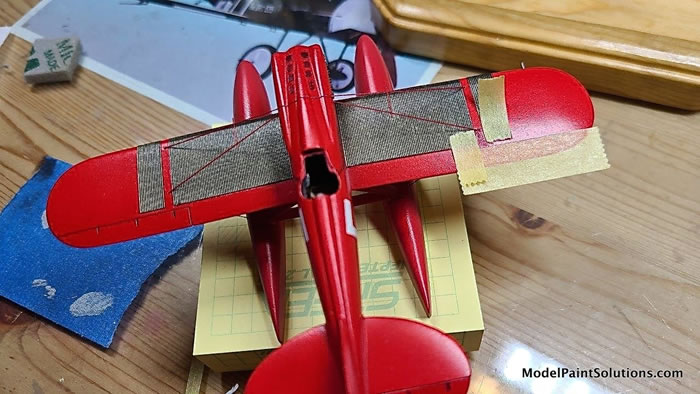
Now we come to another late build crisis for which I’m notorious. When securing literally the last bracing wire on the highly visible upper wing, somehow a flicked a glob of CA glue onto the surface and didn’t see it until it was partially cured. I let it solidify for a couple of minutes, but my attempt to then excise it with an #11 blade resulted in a divot going down to the (tough) Krylon primer. After what I knew would be a fruitless attempt to hand paint a touchup, I decided to bite the bullet and do the surgery that would be needed:
-
Applied filler (Perfect Plastic Putty) and smoothed area
-
Masked radiators in affected area
-
Prepared stand-off hole mask for airbrushing
-
Reprimed with Mission White Primer
-
Reapplied multiple light coats of red
-
Touchedup the radiators in a couple of spots, with Mission Brass and the “Rimell” wash
-
Reapplied CP30
-
Removed all masks
-
All of the above while trying not to damage bracing
The hair-raising repair is actually pretty decent, and far better than leaving my self-inflicted problem in place.
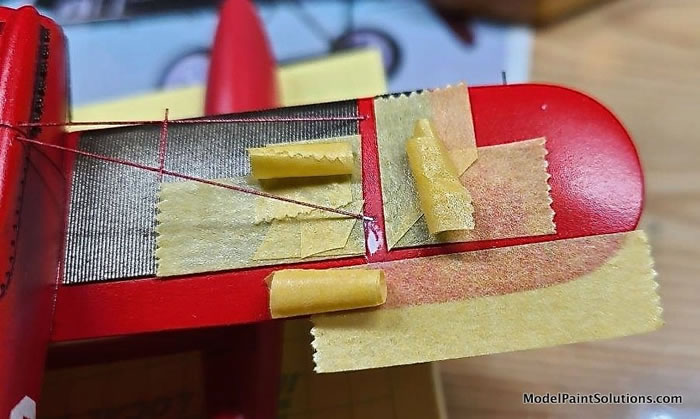
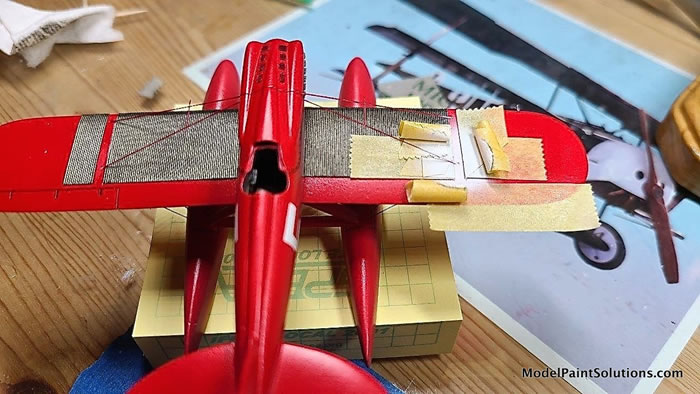
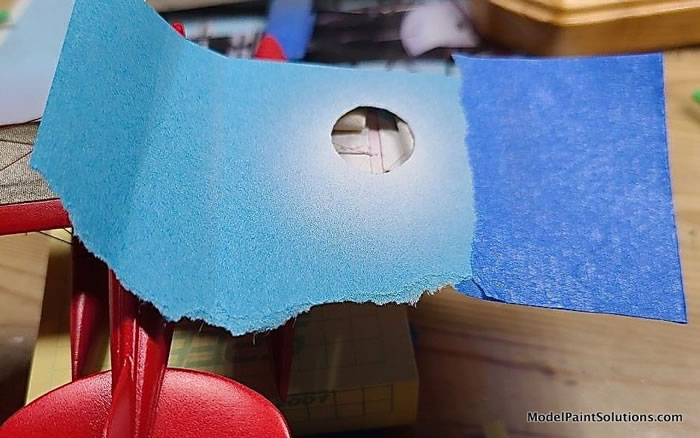
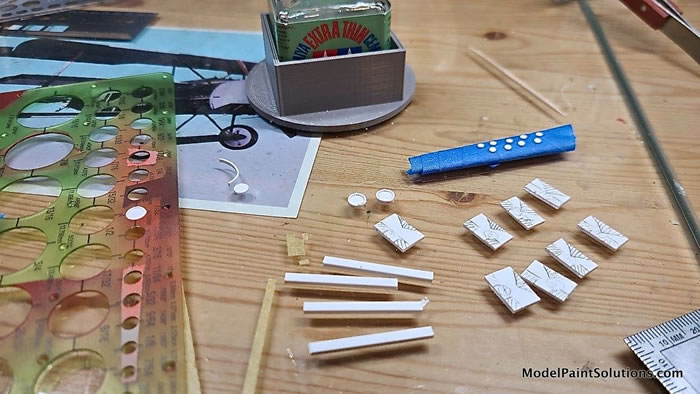
Seaplanes really come to life when paired with beaching gear, so I endeavored to scratchbuild a set based on photos. Some liberties can be taken here, and I did. White styrene was painted with Mission Brown, then subjected to oil-based washes for depth. The two float segments were connected with brass rod, which was treated with silver Sharpie. I didn’t get the fit of the gear to the port float quite right and I’m still not quite sure what happened – but I’m not redoing it.
Seaplanes and beaching gear REALLY come to life if mounted on a decent base. I created a simple section of concrete tarmac using 0.020” sheet styrene, some scribing, some surface-roughing with Tamiya Thin Cement, passes of Mission Slate Gray, and a dark wash. Easy, quick, and effective.
I planted a little grass peaking through the slab seams, positioned the proud Maj. De Bernardi figure, and declared that my order to build this kit at all costs had been carried out.
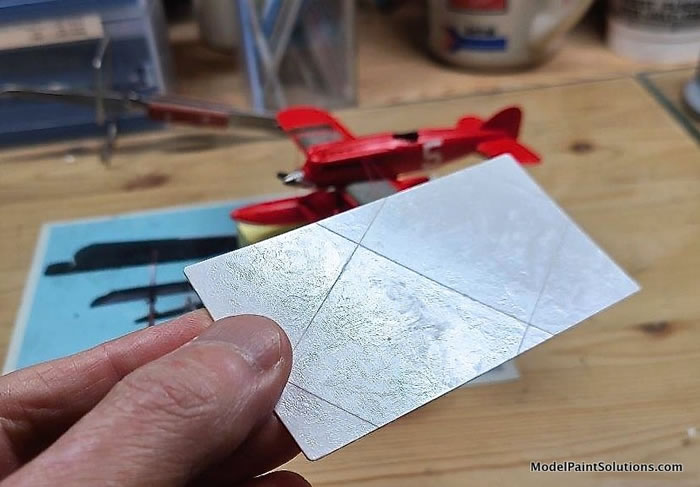
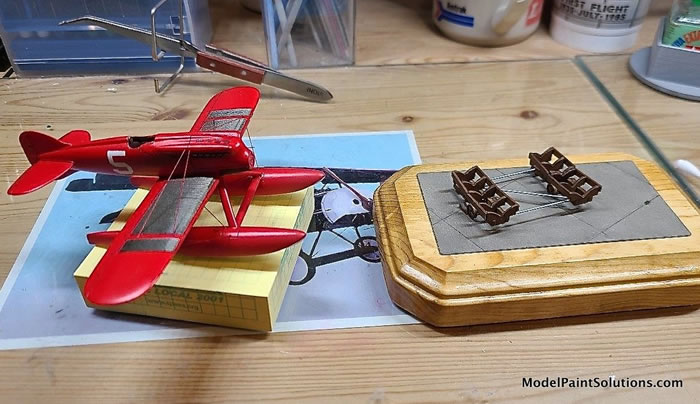
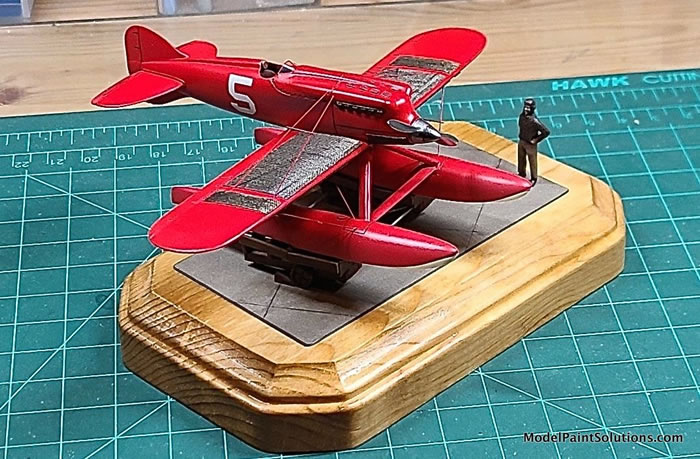
I’m an ardent student and fan of the Schneider Trophy races, and the Macchi M.39 is an important piece of that story. I’m really glad to finally build this gorgeous machine. This kit had been in my stash a long time and I remember thinking “wow, this will be hard” in the mid-2000s. After doing many gritty builds since then, it was not a weekend edition by any means, but just a matter of solving a few problems. That’s the only way to have a subject like this in your case.
References
-
Idrocorsa Macchi (Macchi Seaplane Racers), Ali D’Italia Speciale 26, Giorgio Apostolo & Giorgio Cattaneo, La Bancarella Aeronautica, 2007
-
The Schneider Trophy Story, Edward Eves, MBI Publishing Company, 2001
-
Macchi M.39, Wikipedia
-
Macchi M.39, This Day in Aviation
-
Schneider Trophy, Wikipedia
Resources
-
Silhouette Cameo 3 electronic cutting tool:
Available from the manufacturer, Micro-Mark, and other outlets.
-
RB Productions British streamlined wire
-
Mission Models Paint
For more painting details from this build visit Modelpaintsolutions.com.
Text and Images Copyright © 2020 by Model Paint Solutions
Page Created 4 August, 2020
Last updated
4 August, 2020
Back to HyperScale Main Page
Back to Reviews Page

|
Home
| What's New |
Features |
Gallery |
Reviews |
Reference |
Forum |
Search